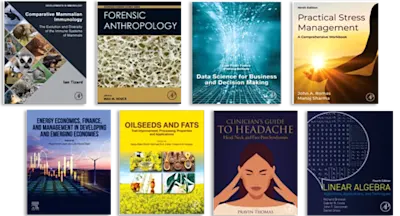
Advances in Planar Lipid Bilayers and Liposomes
A Tribute to Marin D. Mitov
- 1st Edition, Volume 17 - May 11, 2013
- Imprint: Academic Press
- Editors: Aleš Iglič︎, Julia Genova
- Language: English
- Hardback ISBN:9 7 8 - 0 - 1 2 - 4 1 1 5 1 6 - 3
- Paperback ISBN:9 7 8 - 0 - 3 2 3 - 2 8 2 8 3 - 3
- eBook ISBN:9 7 8 - 0 - 1 2 - 4 1 1 5 4 1 - 5
Advances in Planar Lipid Bilayers and Liposomes volumes cover a broad range of topics, including main arrangements of the reconstituted system, namely planar lipid bilayers… Read more

Purchase options

Institutional subscription on ScienceDirect
Request a sales quoteAdvances in Planar Lipid Bilayers and Liposomes volumes cover a broad range of topics, including main arrangements of the reconstituted system, namely planar lipid bilayers as well as spherical liposomes. The invited authors present the latest results of their own research groups in this exciting multidisciplinary field.
- Incorporates contributions from newcomers and established and experienced researchers
- Explores the planar lipid bilayer systems and spherical liposomes from both theoretical and experimental perspectives
- Serves as an indispensable source of information for new scientists
Editorial Board
Preface
Contributors
Chapter One. Marin Mitov Lectures: Measuring the Bending Elasticity of Lipid Bilayers
1 Introduction
2 Calculating the Curvatures
3 Volume, Area, and Free Elastic Energy of a Quasi-spherical Vesicle
4 Experimental Quantities
5 Closer to the Reality
6 Formation of Giant Lipid Vesicles
7 Experimental Setup: Stroboscopic Illumination Module
8 Data Processing
9 Conclusion
Acknowledgments
References
Chapter Two. Formation of Curved Membranes and Membrane Fusion Processes Studied by Synchrotron X-ray-Scattering Techniques
1 Introduction
2 Synchrotron Light for Membrane Response Analysis
3 Bending and Packing in Curved Membrane Systems
4 Membrane Fusion
5 The Lamellar to Primitive Cubic Phase Transition
6 The Lamellar to Gyroid Cubic Phase Transition
7 The Lamellar to Inverse Hexagonal Phase Transition
8 Conclusion and Perspectives
Acknowledgments
References
Chapter Three. Overview of a Quest for Bending Elasticity Measurement
1 Introduction
2 From GUV Fluctuations to Bending Elasticity Measurements
3 Conclusion
References
Chapter Four. Extracting Interaction Parameters and Intrinsic Properties of Membrane from Correlations of Giant Vesicle Shape Fluctuations
1 Introduction
2 From the Shape Deformations of Lipid Bilayers to the Flickering Technique
3 Material and Methods
4 Extracting Material Parameters from Membrane Conformational Correlation Functions
5 Outlook
Acknowledgment
References
Chapter Five. Lipid Bilayers and Membranes: Material Properties
1 Introduction
2 Material Constants of Bilayers and Membranes: Overview and Discussion of Experimental Data
3 Concluding Remarks
Acknowledgment
References
Chapter Six. Interaction of Polylysines with the Surface of Lipid Membranes: The Electrostatic and Structural Aspects
1 Introduction
2 Materials and Methods
3 Electrokinetic Measurements in the Liposome Suspension
4 BP of Membranes
5 PL Adsorption at the Lipid Monolayers
6 Isothermal Titration Calorimetry of Liposomes in the Presence of PL
7 AFM of PLs at the Surface of Bilayer
8 Interaction of Lysine with Lipid Membranes
9 Lysine at the Membrane Surface: Analysis by MD
10 Speculations on PL Interaction with Lipid Bilayers
Acknowledgments
References
Chapter Seven. Developing Cell-Scale Biomimetic Systems: A Tool for Understanding Membrane Organization and Its Implication in Membrane-Associated Pathological Processes
1 Concept of Membrane Rafts and Their Cellular Functions
2 Cell-Scale Biomimetic Systems as a Tool to Study Membrane Organization and Functioning
3 Effect of Sphingolipids on the Formation of Membrane Domains and Their Morphology in Biomimetic Systems
4 Visualization of Enzyme Activity in Biomimetic Systems
5 Conclusions and Biological Implications
Acknowledgments
References
Chapter Eight. Carotenoid–Lipid Interactions
1 Introduction
2 Characteristics of Carotenoids
3 Model Membranes
4 Methods of Investigation
5 Carotenoid–Lipid Interactions
References
Chapter Nine. Theory of Phase Transitions: From Magnets to Biomembranes
1 Introduction
2 Phase Transitions and Statistical Mechanics
3 Theory of Phase Transitions
4 Effects of the Interaction Potential on the Transition
5 Application to Biomembranes
Acknowledgments
References
Chapter Ten. Interaction of Cadmium and Mercury Ions with Bilayer Lipid Membranes Containing Channels
1 Introduction
2 Materials and Methods
3 Results and Discussion
4 Conclusion
References
Chapter Eleven. High-Resolution Solid-State NMR of Lipid Membranes
1 Introduction
2 Experimental Considerations
3 Applications
4 Other Applications and New Directions
5 Summary
Acknowledgments
References
Chapter Twelve. Thermal Fluctuations of Phospholipid Vesicles Studied by Monte Carlo Simulations
1 Introduction
2 Thermal Fluctuations and Elasticity in Two Dimensions
3 Thermal Fluctuations and Elasticity in Three Dimensions
4 Discussion
References
Subject Index
- Edition: 1
- Volume: 17
- Published: May 11, 2013
- No. of pages (eBook): 382
- Imprint: Academic Press
- Language: English
- Hardback ISBN: 9780124115163
- Paperback ISBN: 9780323282833
- eBook ISBN: 9780124115415
AI